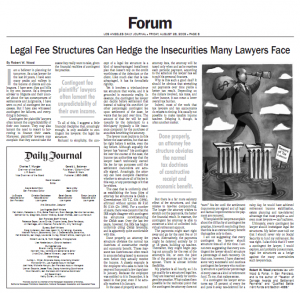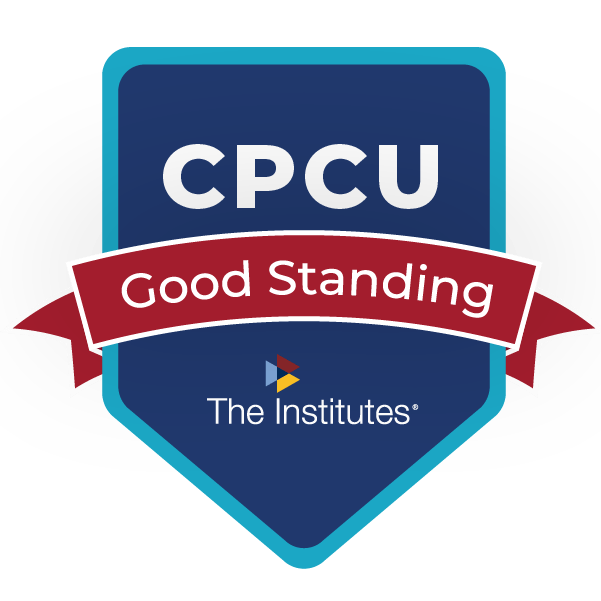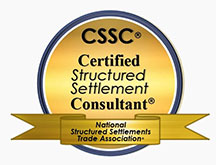Daily Journal Article on Attorney Fee Structured Settlements
Let’s face it! Plaintiff attorneys ride a roller coaster when it comes to cash flow. When cases settle, the money can be very rewarding. When a dry spell hits, the cash flow stinks! Especially when handling class action and similar cases where the costs associated with developing and trying the case can be high and the time until settlement long.
When cases do settle, attorneys get paid an appropriate contingency fee. Quite often though, they end up giving a bunch of it, unnecessarily, to Uncle Sam. Proper planning can help mitigate this tax bite ensuring attorneys pay no more in taxes than they need to and keep more of what they earn.
The Los Angeles Daily Journal recently featured an excellent article on the subject of Structured Attorney Fees written by a nationally recognized expert in the field. Robert W. Wood, Esq. literally “wrote the book” on this particular topic. As author of “Taxation of Damage Awards and Settlement Payments” and many other articles relating to this subject matter, Rob frequently consults for clients who need legal guidance on tax matters involving pending settlements. His article, attached here for your convenience, can serve as a primer for plaintiff attorneys seeking to add a level of financial certainty to their otherwise feast-or-famine practice.
Click HERE to read the Daily Journal article
The popularity of Structuring Attorney Fees has increased dramatically in recent years. So much so that it now constitutes nearly 25% of my personal practice. Many plaintiff attorneys for whom I helped structure portions of their fees years ago consider this choice to have been one of the smartest financial decisions they’ve ever made. And who can blame them for feeling so satisfied? After all, a tax dollar not-paid that earns interest over time can end up being much more than a dollar earned.
So as the rest of us wait for the return of the $11 trillion of wealth we collectively lost in our 401(k) and home equity accounts, attorneys who structured their fees are secure in the knowledge they are benefiting from wise decisions made years ago. They earned guaranteed interest on pre-tax money they otherwise would have paid out in taxes long ago.
With year-end tax planning just around the corner, practitioners are invited to call anytime I can answer any questions about structured attorney fees and show you how valuable this tax advantage can be.
Posted: October 8, 2009 | Category: Blog, Newsletter, Structured Settlements | Comments Off on Daily Journal Article on Attorney Fee Structured Settlements
Structured Settlement Talk: Historical Interest Rates
Interest rates got you down?
Are you holding off making financial commitments that are tied to long-term interest rates (i.e. structured settlements) because you believe rates are certain to bounce higher in the near future?
While it may seem sensible to stash your cash in liquid, low interest bearing accounts because you believe brighter days are just around the corner, history suggests you may be waiting for awhile.
According to data extrapolated from Irrational Exuberance, (Princeton, 2005), only three times since 1871 have long-term interest rates dipped below 4% and remained there for longer than a year. Most of us were not alive in 1880 and 1924 when those first two situations occurred. But 2008 delivered a dizzying reality check to all of us. In October, 2008, long-term interest rates fell below 4% and have remained there since.
So using the past 138 years as a reference point, how long might we expect these rates to stay at these levels if history repeats itself?
Let’s have a look:
- 1880: Rates remained below 4% until 1911 – 31 years
- 1924: Rates remained below 4% until 1959 – 35 years
- 2008: Rates may remain below 4% until (gulp) 2041? – 33 years ?!?!
Since no one can accurately predict the future, no one knows for sure how long interest rates will remain at these levels. Sure, they could and very well may head higher. But some historical precedent exists that leaves open the possibility we may need to get used to this new financial reality.
When Neil Young sang “Now that you found yourself losing your mind are you here again? Finding that what you once thought was real is gone and changing?” he likely wasn’t imagining the state of interest rates in 2009. But he may as well have been. Certainly what we all thought was real just a few short months ago is indeed gone and changing. And if we are to keep from losing our own minds, the sooner we all adjust to the new reality, the better off we’ll certainly be.
Posted: September 24, 2009 | Category: Blog, Newsletter, Structured Settlements | Comments Off on Structured Settlement Talk: Historical Interest Rates
AirCraft Casualty Emotional Support Services
The Finn Financial Group Proudly Supports:
AirCraft Casualty Emotional Support Services

1996 was shaping up to be an amazing year for Heidi Snow! The Honors graduate of the University of Wisconsin had recently begun a promising career as a trading assistant on Wall Street. She was living the dream in the always dynamic City That Never Sleeps. And she was in love.
Michel Breistroff also had much to be cheerful about during the summer of 1996. A recent graduate of Harvard University and the brightest star on France’s national hockey team, professional squads in Europe were vying for his services. For him, the future could not have been more promising either. He, too, was in love. With Heidi. And they planned to marry.
Two young lovers engaged to be married living in one of the most vibrant cities on earth? How could life get any better?
That summer, Michel needed to return to France to begin training for a hockey tournament and prepare for his professional hockey career. So on July 17, he bid his fiancee adieu and boarded a plane for Paris. Heidi was unable to accompany him on this trip but planned to join him in Europe the following week where the two of them would continue to lay the foundation for their future together.
But a cruel fate designed an alternate route for this beautiful, happy couple just coming into the prime of their lives. Shortly after take-off, TWA Flight 800 exploded over Long Island Sound killing all 230 people on board. Michel was gone.
As one would expect, feelings of denial, disbelief and overwhelming grief overcame Heidi when she learned of the explosion. Nothing prepares a person for the sudden and violent loss of a loved one. In an instant, Heidi’s world changed forever and her future dreams, once so full of joy, shockingly and permanently became her worst nightmare from which she doubted she would ever awake.
Along with so many others who lost someone dear that fateful day, Heidi could not fill the emptiness she felt in her soul. The crisis intervention she received immediately following the disaster was very helpful but a void was left when they moved on to the next catastrophe. There had to be more. There had to be something that could help her cope.
Unable to find resources to help heal her suffering heart and confront her sorrow in a fashion that she needed, Heidi reached deep within her grief to create an organization dedicated to helping others similarly affected. Thus, out of her own personal loss was born AirCraft Casualty Emotional Support Services, a grief-mentoring nonprofit organization that reaches out to help anyone who has been impacted by an air disaster. (Click HERE to watch a video of Heidi’s story)
With a supportive Advisory Board which included Mayor Rudy Giuliani, Governor George Pataki and Rabbi Harold S. Kushner, ACCESS began connecting people who needed help with those who truly understood their special need. From that simple idea has grown an amazing support organization that continues to expand its reach. ACCESSwas there for the friends and families of 9/11 victims. And they reach out to survivors every time an aviation disaster occurs. Their only mission is to help facilitate the grieving process.
When I first met Heidi, I was immediately drawn to her foundation because of the natural intersection of her life’s work and mine. Whereas ACCESS focuses on helping people overcome the emotional effects of air disasters, I knew that structured settlements had helped many of these same people overcome the daunting challenges that confronted them when they needed to make important financial decisions at a crucial juncture in their lives.
I thought about Robin, a young widow with three children whose husband, Scott, was killed in a small plane crash in Alaska in the early 90’s. Despite the fact that Robin and I met under such unhappy circumstances, I am extremely proud to have played a role in helping her put her financial life together following her tragic loss.
I was touched when I received a letter from Robin not long after we concluded her structured settlement. She thanked me for helping her honor Scott’s memory, for helping her to take care of his children and for “being sensitive to (her) broken heart.” If only an organization likeACCESS has existed at the time because I know it would have eased Robin’s suffering.
I thought about a guy who went to my high school whose life was also cut short when he was killed in a small private plane crash leaving behind a widow and three small children. Though he graduated nine years before me, like everyone else in town I was proud of our alumnus’ accomplishments on the baseball diamond and deeply saddened by his untimely death as was the entire New York Yankees organization when their captain, Thurman Munson, died. I wish there had been an ACCESS for the Munson family in 1979.
If you know anyone who is suffering from the aftermath of losing someone they cared about as the result of a commercial, private or military air disaster, please let them know they do not need to suffer alone. Have them contact ACCESS. They will listen. They will understand. And they will care.
I’m proud to call Heidi Snow a friend of mine and proud to be a continuing sponsor of her work through ACCESS. To learn more about Heidi’s touching story or to find out how you or your company can support her cause, contact accesshelp.org.
Posted: September 14, 2009 | Category: Newsletter | Comments Off on AirCraft Casualty Emotional Support Services
21st Century Security Scoreboard: 130-0
Safety. Security. Solvency.
These “other three little words” that mean so much have taken on renewed importance this past year for anyone making decisions about their financial futures. “Winning” suddenly seems a whole lot less important than simply “Not Losing.” At least as far as account balances are concerned.
And since we no longer can take for granted these three fundamentals we’ve come to consider our financial birthright, I thought it worth taking a moment to reflect on the safety and security of some of the options people have available to them when choosing what to do with their settlement proceeds. So with football season upon us, what better way to illustrate the distinctions between choices than with a . . .
21st Century Security Scoreboard
Banks – 130
Structured Settlements – 0
“Wow!” you might say. “What a drubbing! The banks sure have dominated structured settlements this century!” And you would be right! You would be right, that is, provided you were keeping score on FAILURE!
Between October of 2000 and August 14, 2009, 130 banks have failed according to fdic.gov. Furthermore, an article in yesterday’s papers highlighted the negative impact this strain has had on the FDIC Reserve balances which have dropped dramatically since 2007.
So what does that goose egg up there on the scoreboard next to Structured Settlements mean? Right again! Not a single life insurer that offers structured settlement annuities has failed this century. That’s right. None. Zilch. Zippo. And unlike the zeroes on most scoreboards, this is a tally everyone can be proud of.
Structured Settlement Life Insurers have a long history of honoring the promises they make to accident victims. Further, over the past 20 years, the National Association of Insurance Commissioners developed several model laws and regulations designed to strengthen the states’ solvency monitoring capabilities.
And even though life insurers reported a collective net loss of $52 billion in 2008 (naic.org), it’s reassuring to know (to the extent an evaporating fifty-two billion dollars can ever be reassuring) this figure represents less than 2% of their TOTAL net assets. Suffice it to say, despite our current recession, these guys still have a lot of money!
While anything’s possible in the future, history is often a very good indicator of what to expect in the years to come. Since all of the companies offering structured settlements have endured hard times before, survived and even thrived, it’s reasonable to expect they will be there to make the payments they have promised.
And that’s more than many banks can say!
Posted: August 19, 2009 | Category: Newsletter | Comments Off on 21st Century Security Scoreboard: 130-0
Sen. Dick Durbin (D-IL) on Structured Settlements
As part of our commitment to keeping you abreast of developments affecting your lives and careers, we plan to periodically feature videos that we hope you find insightful.
If “a picture is worth a thousand words” then thousands of pictures moving really fast should be worth a billion words! I hope you’ll take the time to check out this and all the videos we feature on our website.
Today’s featured video highlights the comments of Sen. Dick Durbin (D-IL) whose endorsement of structured settlements could not be stronger! This brief video highlights comments he made recently when addressing the National Structured Settlements Trade Association.
“Structured Settlements work and should be protected.”
Sen. Dick Durbin (D-IL)
As the Assistant Majority Leader in the United States Senate, Sen. Durbin’s words carry a great deal of weight in Washington. In addition to his work as a legislator to improve the lives of all Americans, he speaks from personal experience as a former plaintiff attorney who represented clients suffering personal, physical injuries.
I hope you enjoy hearing Sen. Durbin’s positive views on structured settlements as much as I did. Some of the points he emphasizes could not be more appropriate in light of today’s struggling economy.
Posted: August 11, 2009 | Category: Blog, Newsletter, Structured Settlements | Comments Off on Sen. Dick Durbin (D-IL) on Structured Settlements




















